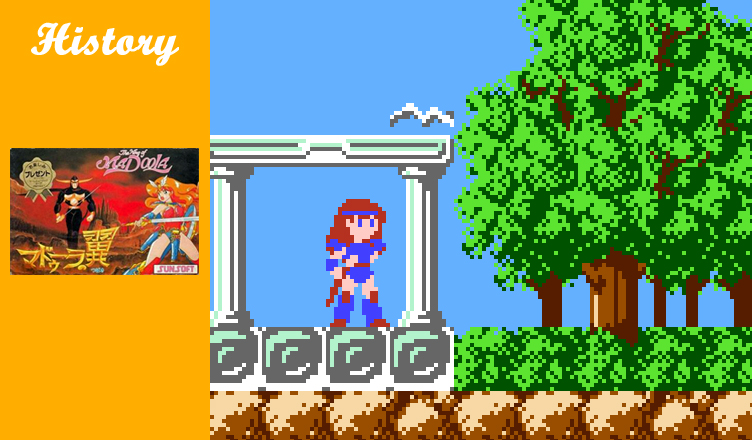Developer: Sunsoft | Publisher: Sun Electronics Corporation | Release: December 18, 1986 | Format: Famicom Disk System | Original price: 4,900 yen (excluding tax) | Size: 512 K
Sunsoft also continued to develop their own original games. Next in line was Madūra no Tsubasa (The Wing of Madoola). It’s an action game where the player controls the sword and magic wielding Lucia. Here it becomes evident that Sunsoft began improving their designs. No longer just blatantly copying others’ games like in the arcade days; they were trying new things. Even if The Wing of Madoola is pretty straight forward at first it soon opens up with more exploration and has the player picking up power-ups that make the character stronger. It’s essentially an action platformer mixed with light RPG elements.
I asked the games designer (and main programmer) Kenji Sada what inspired him to put RPG elements in the game, “I didn’t intend to make an action RPG, but just an action game”, he says. Dragon Quest had popularized the RPG genre in Japan and many games got an infusion of it. Mainly by adding upgrades to make the protagonist grow stronger rather than the story element of RPGs. “A title sold well if it was called an RPG in those days, thanks to Dragon Quest”, Sada continues.
Kenji Sada had joined Sunsoft in 1986. His former high school friend Kenji Kajita had started working there some time before and invited Sada to work there too. Sada had worked as a programmer at T&E Soft where he programmed KEISAN GAME. The Wing of Madoola was his first project when starting at Sunsoft. It was a time of expansion for the companies game division, new and old talent joined forces to make new and different games.
I asked Sada what he studied before starting at Sunsoft and making games. “I read a book about micro computers when I was 11 years old, then got interested in micro computer and programming”. After that he learned assembly language and how to translate it to machine code. He also learned BASIC. There were no schools that taught this back then so he learned it in his free time by reading books and magazines.
I also asked him if he liked games at the time and if so what games, “Of course I liked video games(. We had to go to arcades because there was no consoles when I was a student”.student There were of course some, but none that really was popular in Japan. “I liked the games by Masanobu Endo, not the famous XEVIOUS but his two following games. I was crazy about The Tower of Druaga since its mysterious atmosphere, characters and magic items. But I think GROBDA is the very action game as I know”, he tells me. It’s interesting to know what games these game developers played and what might have inspired them. And when he decides why he likes GROBDA so much it’s clear he really was into games with complex gameplay, “It requires not just aiming enemies but managing resources. The tank requires energy whenever you attack, move and guard from enemy’s beam, so that you need to keep judging next action constantly. It is real thrilling.”. And The Tower of Druaga of course, a game so complex there were notepads on the arcade cabinet for players so write down tips.
One thing that made The Wing of Madoola stand out at the time was the female protagonist Lucia. So why did Sada choose a woman in the main role? “If the protagonist was a boy, Madoola was too similar to Dragon Buster, wasn’t it?”, he said. He adds that he really don’t have a specific reason for making the protagonist a woman. Lucia seems to be the most memorable part of the game, she generates both fan art and cosplay even today.
Kenji Sada tells me he didn’t write the story for any of his games. The title The Wing of Madoola was conceived by designer Kazuyuki Sugiura (Sugiura would design the arcade game Bay*Route in 1989).
The following year The Wing of Madoola was also supposed to be released for the Nintendo VS. System (Nintendo’s arcade hardware based on the Famicom) but that version ultimately never saw the light of day. It was going to be released along Lionex (that was never released in any form).
The Wing of Madoola got a short six chapter Manga in Tokuma Shoten’s Monthly Wanpakku Comic in 1987. It was written and illustrated by the games character designer, manga artist Kenji “Moriken” Mori.
The game ends with a “The End” and no credits, so I asked Kenji Sada for the credits. Here is the long lost credits for The Wing of Madoola.
Planning/team lead/main program: Kenji Sada
Co-program: Kenji Kajita
BG design/graphics and map design: Sugiura
Character design/graphics: Simomura (aka KIRITAN who also worked on “Ripple Island”)
Sound program: Naohisa Morota
Composer: Naoki Kodaka
and 2 helper programmers.
The game received ok reviews and are remembered by people as an ok game of the Famicom era.






